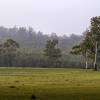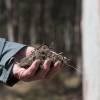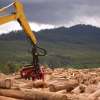
Evandale farm maximising productivity and custodianship through trees
Posted 03 December 2020
Managing trees On-farm benefits Economic benefits and markets Carbon benefits Native regrowth forest management
Three generations of tree planting on Logan, a family run farm at Evandale, has delivered increased water efficiency, increased lamb survivability, and enhanced farm aesthetics.
After two generations of planting, Clare Peltzer explains why she and her brother, Angus, will continue the family tradition of planting trees for the future.
Clare Peltzer’s great grandfather, Pier Grandjean, came to Tasmania from Belgium in 1950 as a businessman and developed Logan as a Merino farm.
More recently, under the management of Clare’s father, Michael, and due to access to gravity-fed irrigation, the farm moved to prime lamb production for the export and domestic market, a business that continues today. Regardless of what the farm produces, trees have always been highly regarded as a tool to maximise productivity and hence, the bottom line.
“My great grandfather recognised that trees were a necessary addition to the farm,” says Clare.
“He chose the pine tree because pines are successful in our soils and sufficiently block the wind, which he knew was going to be very beneficial. We've got predominantly north-westerly winds that from spring through summer can be fairly persistent.”
Clare explains that decreasing the wind speed meant they could increase yields, by reducing evapo-transpiration of the pasture and providing shelter for the lambing ewes.
“Trees are another tool that we can use on the farm to help us become more profitable by looking after the animal’s health and wellbeing, which is the main profit driver.”
“When you plant trees, you do get the initial loss in pasture, but if we're putting in 20 hectares of trees and we're lambing down 8,600 ewes, the 5% to 10% increase in lambing survivability definitely outweighs any hectares lost in the current market.”
Observing the increased yields in the sheltered paddocks over many years, Clare’s father continued to plant through his tenue on Logan.
“Dad planted a lot of pine trees with the help of Private Forests Tasmania in the early 2000’s and now my brother and I have decided that it's our turn to plant trees. With the help of Private Forests Tasmania again, we're going to be planting our trees to also benefit the next generation.”
Increased water efficiency
The Peltzer’s grow white clover and brassicas as sources of fodder for their prime lambs under irrigation. Clare explains that in areas where trees block the prevailing winds, less irrigation is needed over the growing season.
“In the parts of the pivot area that we've got the trees slowing that north-westerly wind our irrigation requirements are substantially less than the un-protected quarters.
"Shelter from trees helps to hold that moisture in the soil. This allows the plant to not feel stressed at all because it always has access to water so continues to produce dry matter without plateauing.”
Increased lamb survivability
With lambing, the Peltzer’s scan their ewes to determine exactly what each ewe is carrying, multiples or singles. Then at lambing time, they count the ewes, and count the lambs and calculate a survivability percentage based on each paddock.
“We know that we have a higher percentage of survival in our lambs in these paddocks with the protection from the pine trees.”

Custodians of the land
When calculating value, Clare notes that sometimes the benefits of improved aesthetics is forgotten, along with the creating wildlife habitats and sequestering carbon.
“We are sharing the land. As farmers we think that it is ours, but in fact we are custodians of the land, and we are sharing it with native flora and fauna and looking after it for future generations. So, I think we do need to replace the trees we removed for our own business ventures,” says Clare.
“We need to look after the assets that we have been fortunate to receive from our families or purchased. And then to hand it on in better condition. That's what my brother and I think anyway.”
Where carbon sequestration is concerned, Claire explains that anything that is photosynthesizing on farms, including perennial pasture, is sinking carbon. Planting trees is another thing that farmers can do to maximise that.
Soil protection – the top ten centimetres is everything
The best farming practices ensure that pastures never get to the point where the soil can be eroded. They always ensure full ground cover with pasture to keep the soil in place. But in extreme weather events, like drought, farmers have less control.
“If there's just absolutely no water, the plants can't survive. So, trying to keep trees in the landscape is really important to protect the topsoil.
“The trees hold the soil close to them down and reduce the wind speed over adjacent paddocks which not only keeps as much moisture in the soil as possible, but it stops dry soil from being blown away.
“For us, the top 10 centimetres is where everything's growing from. So, we need to make sure that that's being protected and retained.





